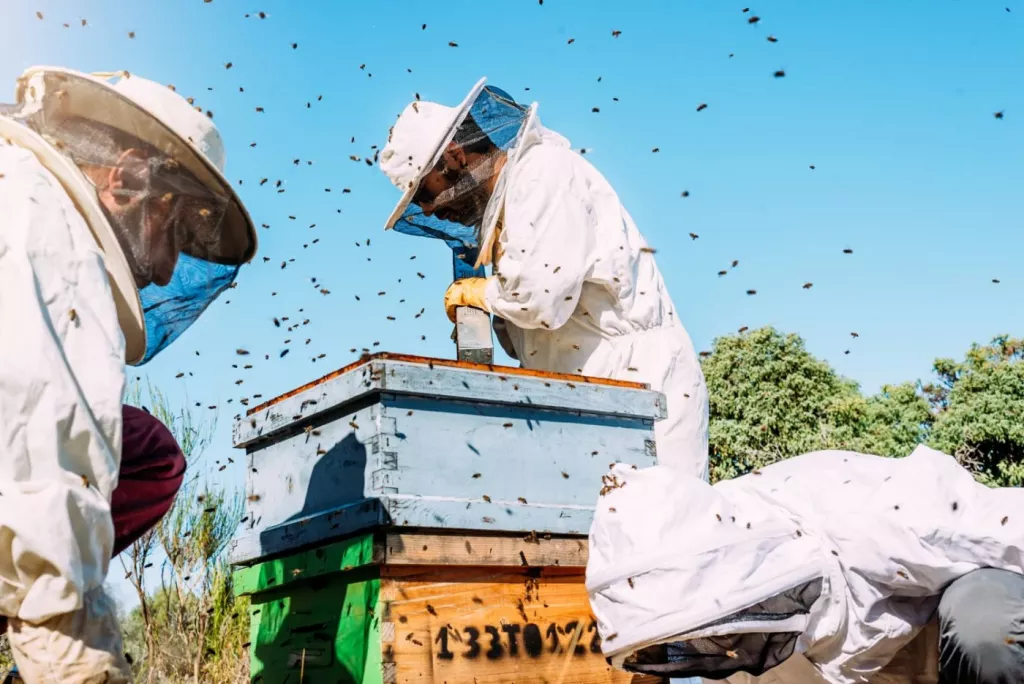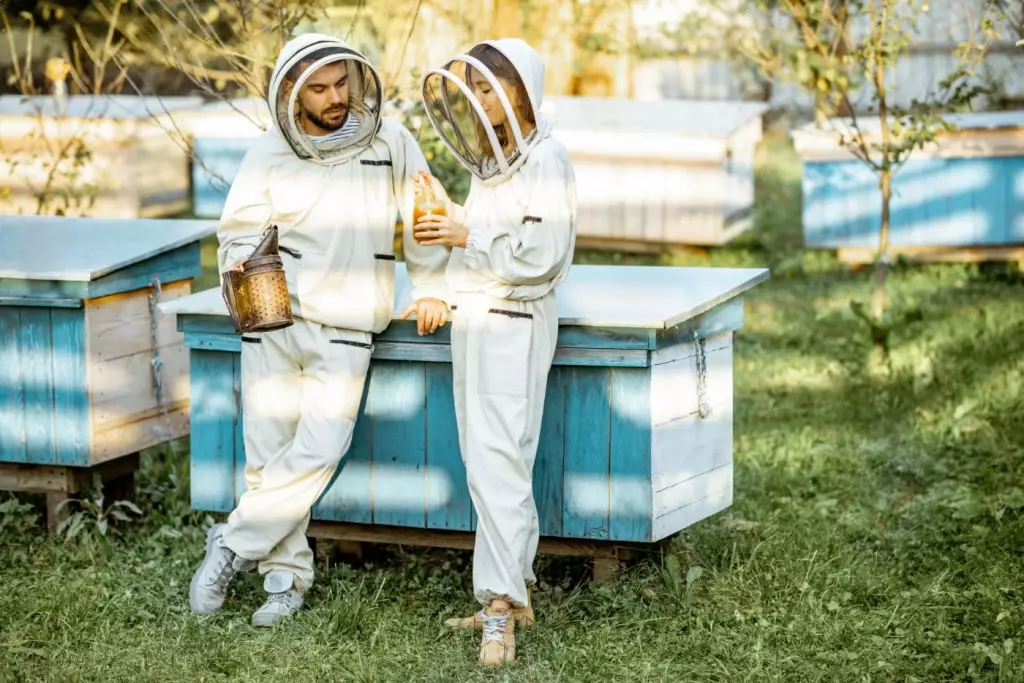How Does a Bee Suit Actually Work? (Why It's White)
Do you want to be a beekeeper but are afraid of being stung? Fortunately, there is a wide selection of protective bee suits available. Those enormous white bee suits with their veiled headgear are striking, but you might wonder whether a persistent bee could get through one.
Bee suits use a single piece of thick white cotton canvas or multiple layers of bee-proof mesh netting to create a full-body bee suit. It will protect the beekeeper from stings as long as it is properly used. With it, you'll be able to protect your arms, legs, and abdomen completely.
The idea of getting stung by bees can be scary to some people. Unfortunately, it is a situation that is part of the job. But don’t worry! Bee suits are here to save you — if you wear it correctly.
Summary
- As long as the bee suit is worn correctly, it will shield the beekeeper from stings. A full-length bee suit is a smart purchase.
- Bee experts believe that bee suits are not totally bee-proof, but rather bee-resistant.
- It is still preferable to wear a beekeeper outfit as opposed to nothing at all.

On this page:
Do Bee Suits Actually Work?
Knowing how painful a bee sting can be and how much more so if you are allergic to bee stings underline the importance of bee suits. If a single bee sting is terrible, imagine hundreds of these tiny needles simultaneously stabbing you.
Bee specialists believe that bee suits are not completely bee-proof but rather bee-resistant. Bees are able to squeeze through even the smallest gaps in your clothing and will occasionally sting you - which will definitely make you more alert.
It's easy to overlook the basics. To prevent a bee from getting into your suit and getting you, always double-check that all the openings are securely closed.
You Should Wear Loose-Fitted Suits
Bee suits are made with user comfort and bee sting protection in mind. Although a tight-fitting bee suit may appear fashionable, it is preferable to go for a loose-fitting option. Since you'll be bending and stretching a lot while working with bees you'll want as much freedom of movement as you can get.
Loose-fitted suits allow you to move freely. Suits must also be fastened at the wrists and ankles. If your suit is too small, the skin around these places will be occasionally exposed, increasing sting risk.
Why Bee Suits Are Typically White
The majority of bee suits are white or at least pale in color. Bee suits are white for three main factors:
- White clothing does not generate as much heat as dark clothing. Therefore, the most comfortable color for a bee suit to wear is white.
- Bees perceive color. White has been proven to be a neutral color to bees. It is not a naturally frightening color to bees and bees seem to show little interest in white.
- Last but not least, the white color of the suit makes it simpler to see whether a bee has followed you outside the hive.

Types of Bee Suits
Beekeeping suits come in three variations: full suit, half suit, and veil. Full suits are the most protective clothing options since they are made of sturdy material and contain a hood that completely covers the head and face. A half-suit has a full hood, but the face is exposed. Veils are a type of half-clothing covering the face but exposing the head and neck.
Cotton
Because cotton is so widely available, this material is rather popular. However, cotton is also a good material for beekeeper suits, as some traditional beekeeper outfits are constructed from cotton.
Some cotton suits have a tendency to be pretty thick, making it very difficult for bees to attempt to sting you through the suit. The benefit of cotton is that it can be made as thick as necessary for your beekeeping suit.
Nylon
A nylon beekeeping suit isn't the thickest suit you'll find on the market. You might question how this can be a helpful technique for guarding against bee stings.
However, nylon can shield you against bee stings because it is effective at wicking away water and moisture. Simply put, if the bees attempt to lay their feet on the suit to sting you, they will eventually slide off the material.
Mesh
This material is constructed from synthetic fabric that appears to be woven to make a net-like fabric with little holes. Mesh beekeeping suits are often built of multiple layers of mesh because a single layer won't properly shield you from bee stings.
Mesh has the advantage of being able to be made as thick as necessary to provide you with the level of bee sting protection you require. It's also advantageous because, despite its thickness, air can still enter through the tiny holes to keep the suit breathable.
Can Bee Suits Protect You From Wasp Sting?
In contrast to bees, yellow jackets and wasps are a pest. Yellow jackets may occasionally decide to build a nest on or near your property, including within your apiary.
The worst part of it all is that yellow jackets are a type of predatory insect that will attack bees in addition to other insects. In fact, yellow jackets prioritize eating honey bees in their diet.
As a result, if a yellow jacket nest is close by, you must protect your bees from these predatory insects because not only will they consume your bees, but they will also invade their hives and loot them for larvae and honey.
But does your bee suit also protect you against yellow jackets as it does from bees? After all, wasps will sting you as well, so you need to protect yourself when dealing with a yellow jacket nest.
Yes, a bee suit can generally still shield you from a yellow jacket's sting. The issue is that yellow jackets can sting you repeatedly because their stingers will remain attached even when repeatedly using it.
In that aspect, a bee suit can protect you from a yellow jacket's sting, but because it can sting you indefinitely, the likelihood of their stingers entering the bee suit is significantly higher.
Best Bee Suit on the Market
Humble Bee 420 Aero Bee Suit
The Humble Bee 420 Aero Bee Suit, which includes everything you need for a proficient and effective beekeeping suit, is the most fantastic beekeeping suit currently available in the market.
Its material is a blend of synthetic fibers that allow you to remain cool and comfortable throughout the day. In addition, it contains a thin foam insert that will keep you shielded against bee stings in all of your most exposed areas.
If you are interested in the Humble Bee 420 Aero Bee Suit, visit this Amazon link here.
Home-Made Bee Suits
If you don't know where to find a beekeeping suit or buying one is out of your budget, you may create one at home, but there is no assurance that it will be as effective as the ones you can purchase. However, having a homemade beekeeping costume is still preferable to having none, even if it is temporary.
Follow the steps below on how to make a homemade bee suit.
- Get a white, loose-fitting, long-sleeved shirt. It must be loose-fitting so the stingers cannot easily penetrate your skin.
- Instead of using buttons, apply Velcro on them. Be sure to cover the areas from the neck to the bottom of the shirt so that there are no gaps when the shirt is buttoned.
- Pull your collar up, then attach Velcro to the area where the two collar ends meet in the front. This guarantees that your neck is likewise well-protected. In order to keep bees out, make sure your armhole is adjusted to be tighter by adding Velcro.
- For the headwear, get any type of hat with a brim. The brim will prevent the net from touching your face, ensuring that you can still see and breathe normally. Cut a length of net large enough to fit around the opening of the headpiece. Check to see that the net extends all the way to your shoulders.
- Make sure there are no gaps in the net before taping it to the cap. Your entire neck region and both sides of your head should be protected by the net, extending to your shoulders.
- Get yourself a pair of thick, loose track or jogging pants. Ensure the pants are taped at the waist and the ankles to prevent any openings for the bees to use as an entry.
- Wear a pair of rubber gloves that may be tightened at the wrist using an elastic bracelet. To prevent bees from entering your shoes, you should wear ankle-high boots.
